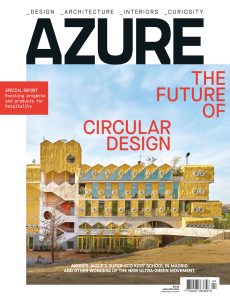
AZURE – March-April 2023
English | 94 pages | pdf | 37.9 MB
In assembling the stories in this issue about circular design, one word kept coming up: value. It surfaced early on in my conversation with Zita Cobb (“All the Right Moves,” page 60), the Shorefast founder and visionary behind Fogo Island’s resurgence. Describing the difference between something that has inherent value versus a status symbol, she recalled a friend of hers, Amos the fisher, who was confused about how a Louis Vuitton purse could sell for thousands of dollars while he couldn’t earn a meagre income hawking his fish. “The economy will start to work,” she told me, “when we practise true cost pricing.” “The economy” is a phrase, Cobb likes to say, that is quick to clear a room. And it’s certainly not the usual scope of this magazine. But if we’re talking about how we can completely rethink the way we do things, we inevitably come around to the question of value, which for too long has been dictated by market factors. If we recentred our perception of value around circularity — how we can benefit the health of the planet and every living thing that thrives on it by considering the full life cycle of a product or project — we would develop a new mindset for designing, making, consuming and living in more equitable relationships with each other and our surroundings.
Cobb used this type of thinking to bring new hope to Fogo Island after industrial fishing had depleted its waters. She began by celebrating members of the community already there and engaging them in the creation of the Fogo Island Inn, from its construction and furniture-making to the crafting of the quilts on its beds — all of it quantified by a radical-transparency device called the Economic Nutrition Label.
Then, through Shorefast, she helped get the independent fishery going again; now, she and her foundation are helping other communities leverage their sense of place through what makes them truly unique: the relationships that bind the community. Using design thinking to bolster an entire place or community is a massive endeavour. But even the design of a building or a furniture collection is an opportunity to reset the program for circularity. Today more than ever, we need to change gears on how we do things. London design firm Pearson Lloyd (“Designing With the Planet as Stakeholder,” page 54) is deeply engaged in this line of inquiry. Tom Lloyd would even go so far as to question why we should always buy new design (a perennial quandary of many a furniture fair is “Do we really need another chair?”) when we can turn to subscription models. But what about the designer’s livelihood, you might ask? Here, again, it comes down to how we can hack our current ideas around value. “The design opportunity,” Lloyd told me, “is to figure out how to make that happen: You have to modify where the value chain and wealth creation is in order to fulfill these opportunities. If you stepped back and said a chair has five lives, and each time you bought it back and released it, the wealth creation could be strong, but it’s a different value stream model.”
By rethinking “value,” we’re also reclaiming our own values. If we want to strive for a healthier planet, one that is more ethical and sustainable, we have several examples to follow — and this issue is brimming with them.
Download from: